Posts Tagged ford family
Clara Ford’s Travel Diaries
When traveling today, it is easy to document our journey through swift clicks of our phones and cameras. The people, sights, and sounds of a moment are captured and recorded through photos, videos, and social media posts making it easy to reflect on where we were and what we enjoyed.
The desire to document a memorable trip has remained a common tradition and in the age of Clara Ford, was accomplished through travel journals or diaries. Even with the advent of photography, film had to be thoughtfully allocated to document the most meaningful memories from a trip.
The Henry Ford's collections include several travel diaries written by Clara Ford dating from 1912 to 1945. Clara did not keep a diary for every trip she took. As the wife of Henry Ford, her travels were frequent and varied. Most of the diaries document her travels overseas, a momentous journey for anyone at that time, and winter retreats to Richmond Hill, Georgia, and Fort Meyers, Florida.
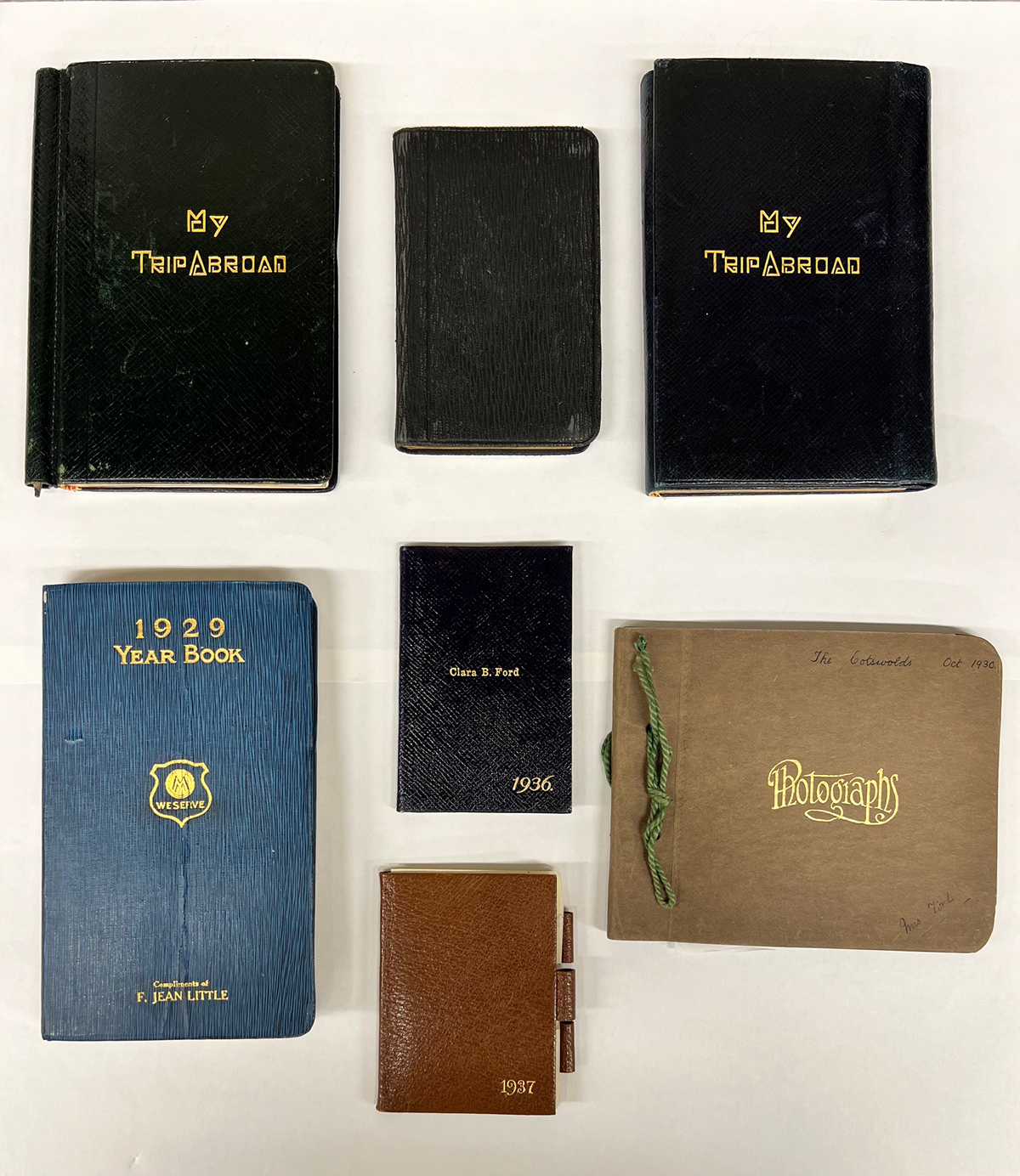
Clara Ford Travel Diaries. Accession 1, Box 105 and 106. / Image by Lauren Brady
Unlike social media posts, travel diaries were not always intended for sharing or future publication. Entries were meant to document travel details and for personal reflection.
This means the writer was often sharing their thoughts more freely. For a notable figure like Clara Ford, travel diaries provide insight into her personal opinions and interests that might have been left out of an official record of her travels. They also provide a valuable record of Clara at a given time and place. They tell us who she interacted with, where she stayed, and what she saw.
The earliest travel diary penned by Clara was for her first trip to Europe in 1912. She, Henry, and Edsel explored sites throughout Great Britain and France.
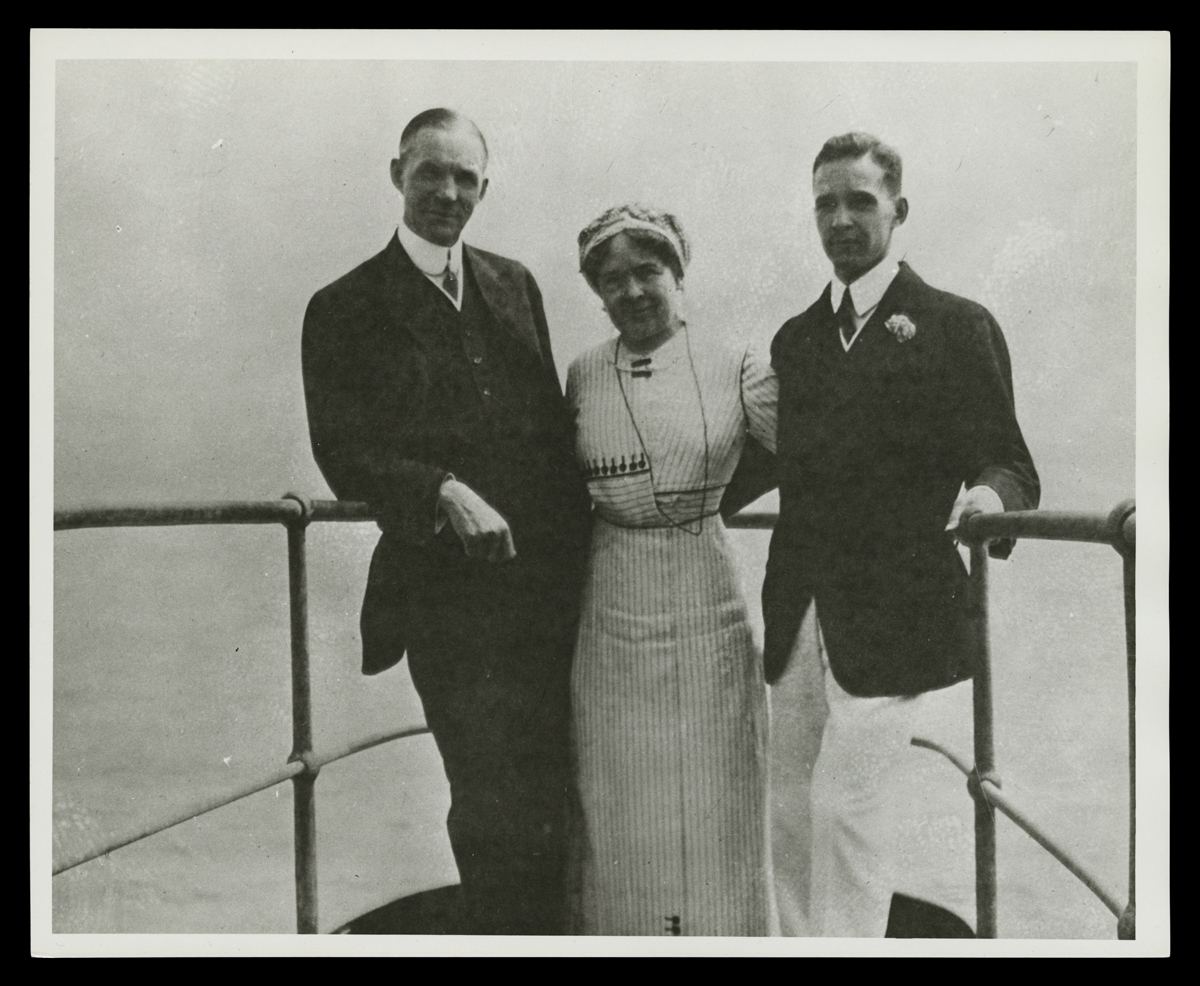
Henry, Clara, and Edsel Ford aboard Ship on their European Trip, 1912. / THF117563
In one of the first entries, Clara documents the time the ship set sail and describes the warm welcome they received. Among flowers, fruits, and candy were several letters from friends wishing them a “Bon Voyage!” Clara references a letter from her close friend, Lulu Wilson, which we also hold in our collection. Connecting archival records like these illustrates a larger picture for historians and researchers.
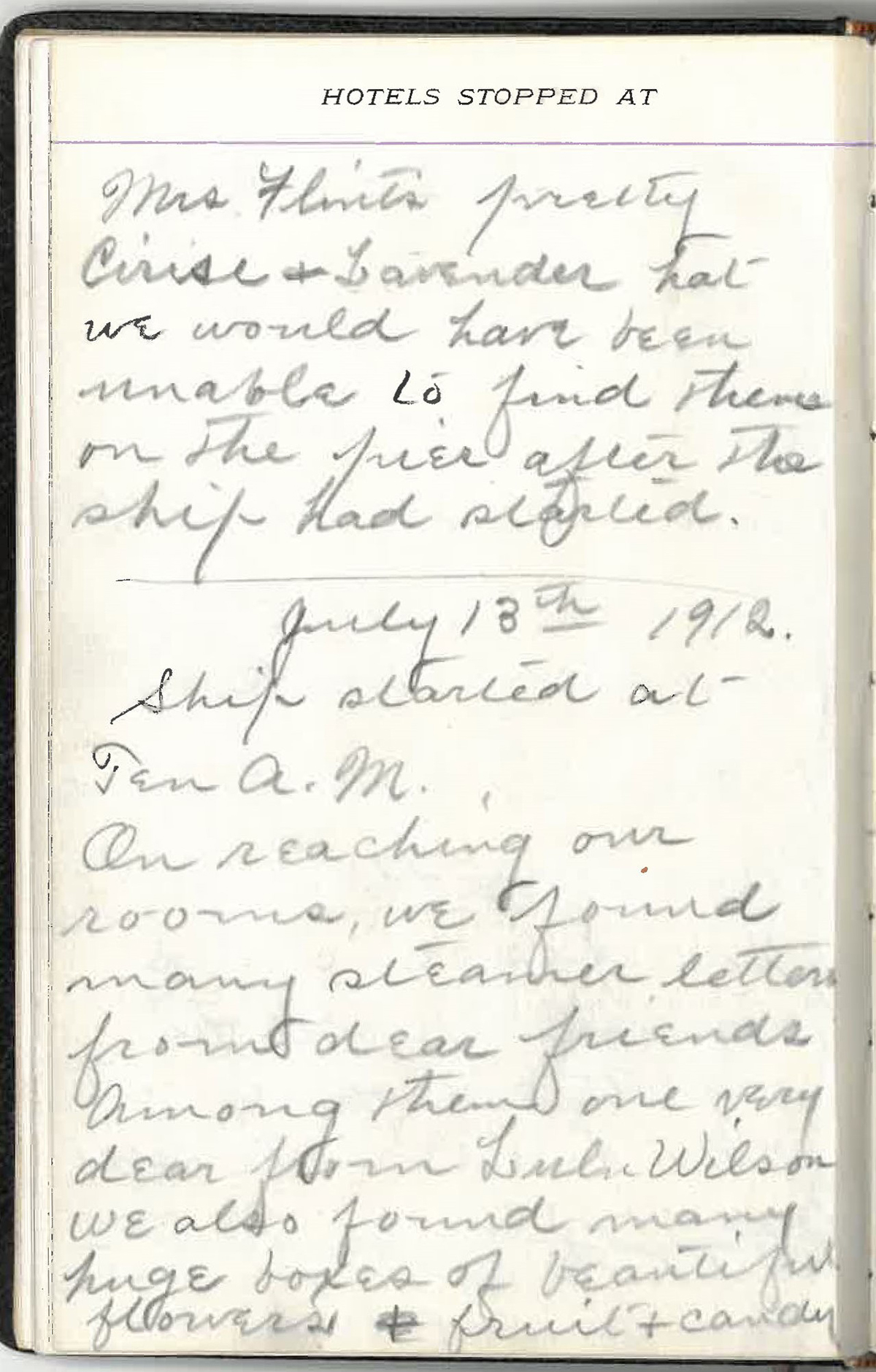
Clara Ford's Travel Diary, 1912. Accession 1, Box 106. / Image by Lauren Brady
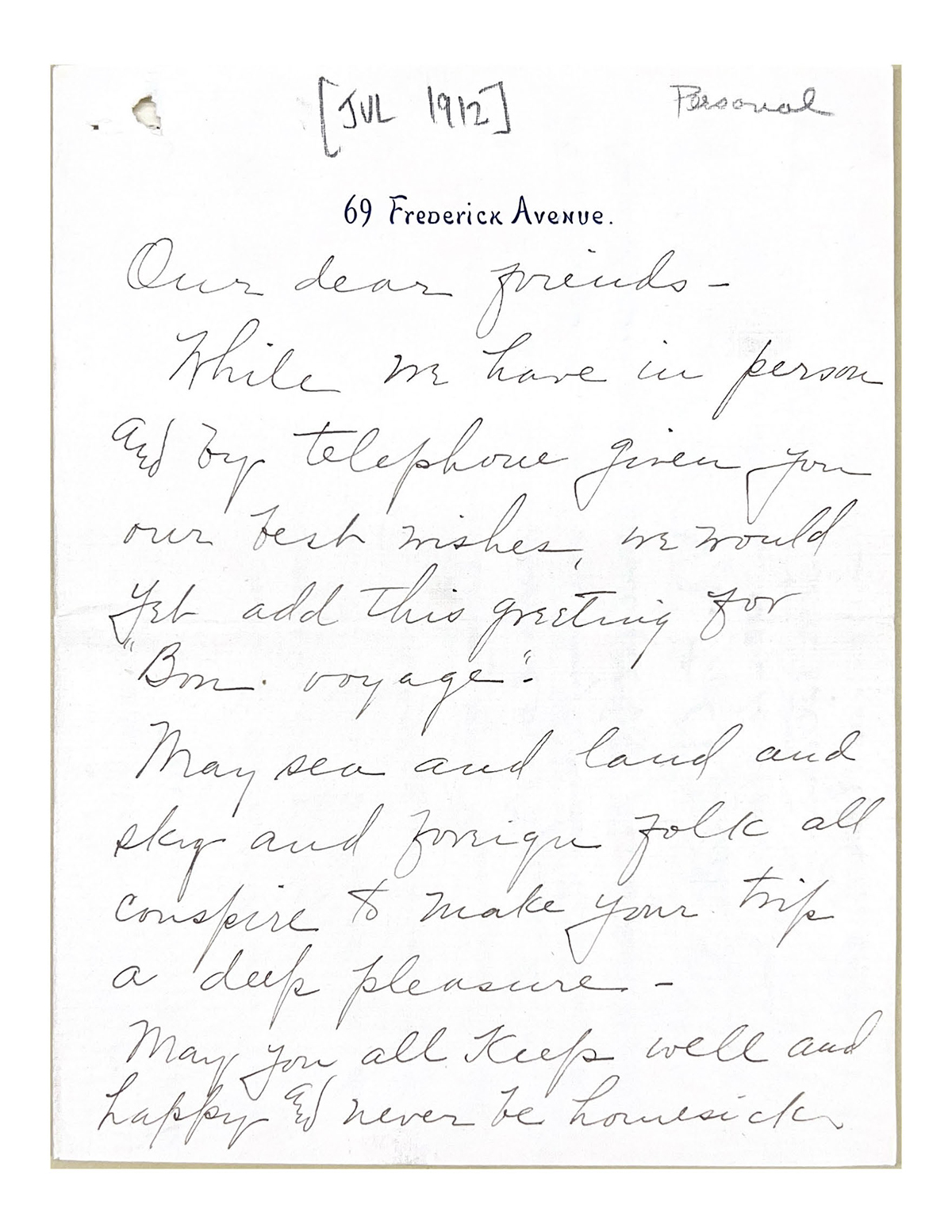
Letter to Clara Ford from her friend Lulu Wilson, July 1912. Accession 1, Box 66. / Image by Lauren Brady
In addition to Clara's diary, we also have Edsel's diary from this trip in our collection.
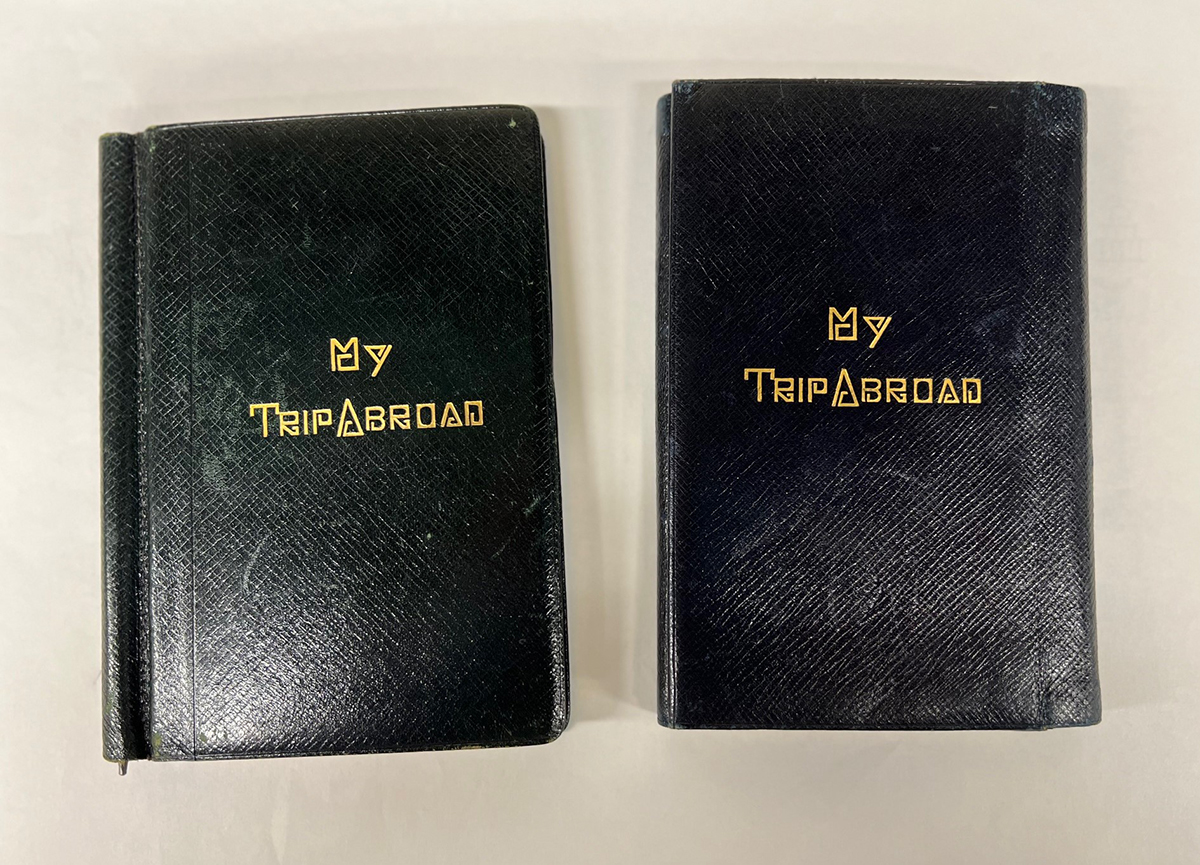
Clara Ford's and Edsel Ford's Travel Diaries, 1912. Accession 1, Box 106. / Image by Lauren Brady
During their travels, they visited Clara's ancestral home. There are parallel accounts of the visit in both diaries. It reads as a meaningful visit for Clara who also describes important genealogical details about her family history that may not have been recorded elsewhere in our archival collections.
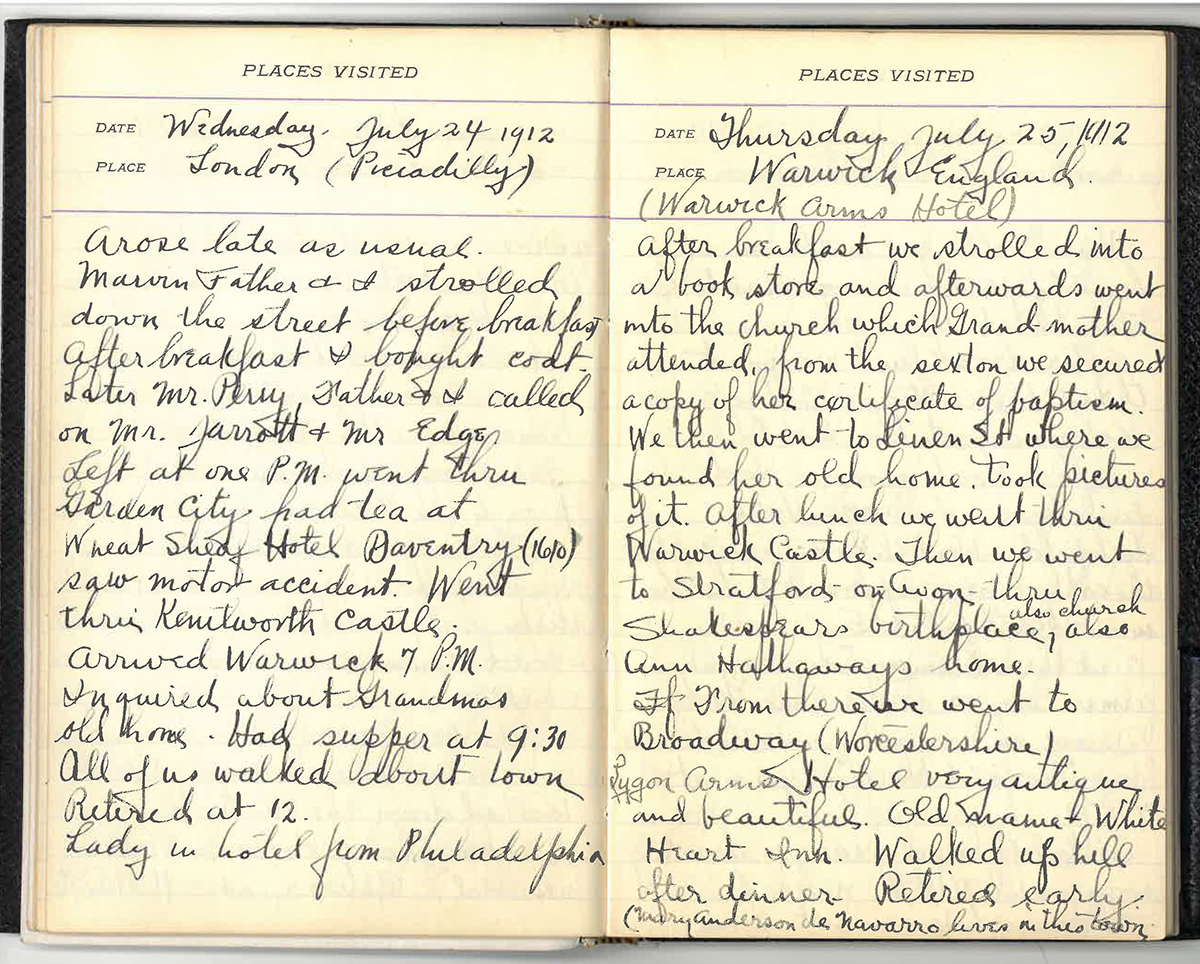
Edsel Ford's Travel Diary, 1912. Accession 1, Box 106. / Image by Lauren Brady
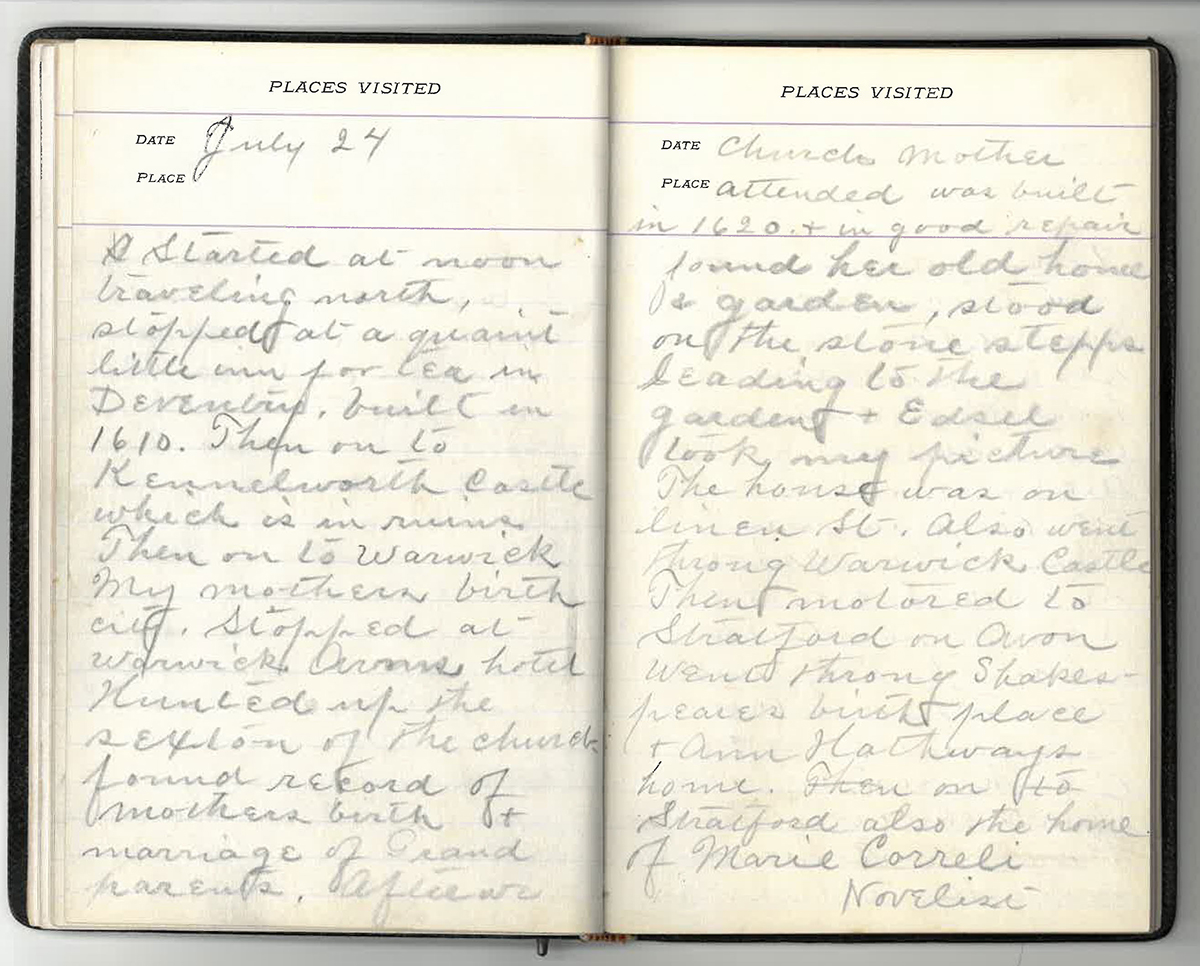
Clara Ford's Travel Diary, 1912. Accession 1, Box 106. / Image by Lauren Brady
The Fords returned to Europe many times, including a trip in 1930 which Clara documented in a diary and a unique photo album. In her diary, Clara makes note of Henry's visit to Buckingham Palace before he departed for the Cotswold region of England where Cotswold Cottage had recently been acquired for Greenfield Village.
This visit received special commemoration in a photo diary with handwritten notes by Clara.
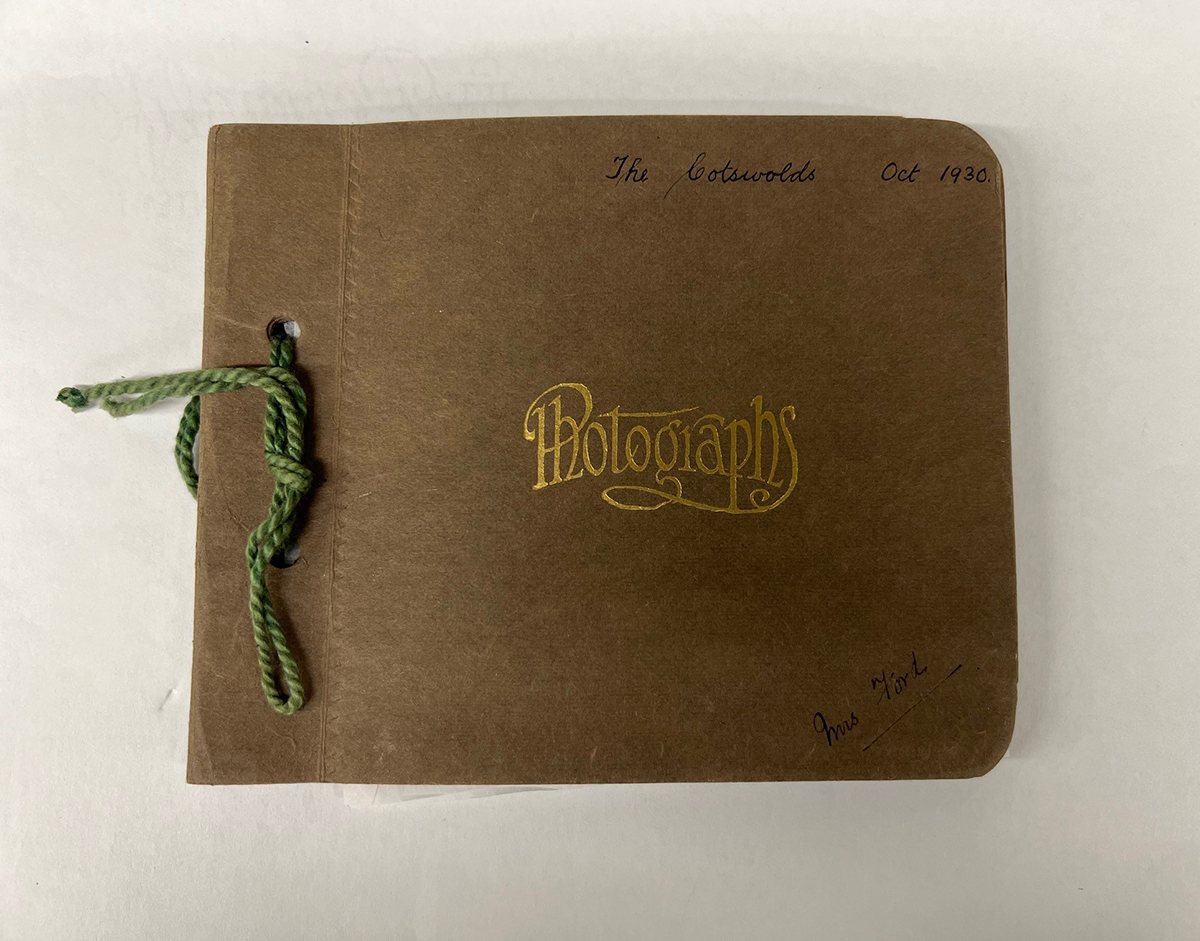
"The Cotswolds" Photograph Album, 1930. Accession 1, Box 106. / Image by Lauren Brady
The album includes several snapshots of their visit culminating with a group photo at the former site of Cotswold Cottage. Clara's notes read like a short story as she describes the photos and recounts details.
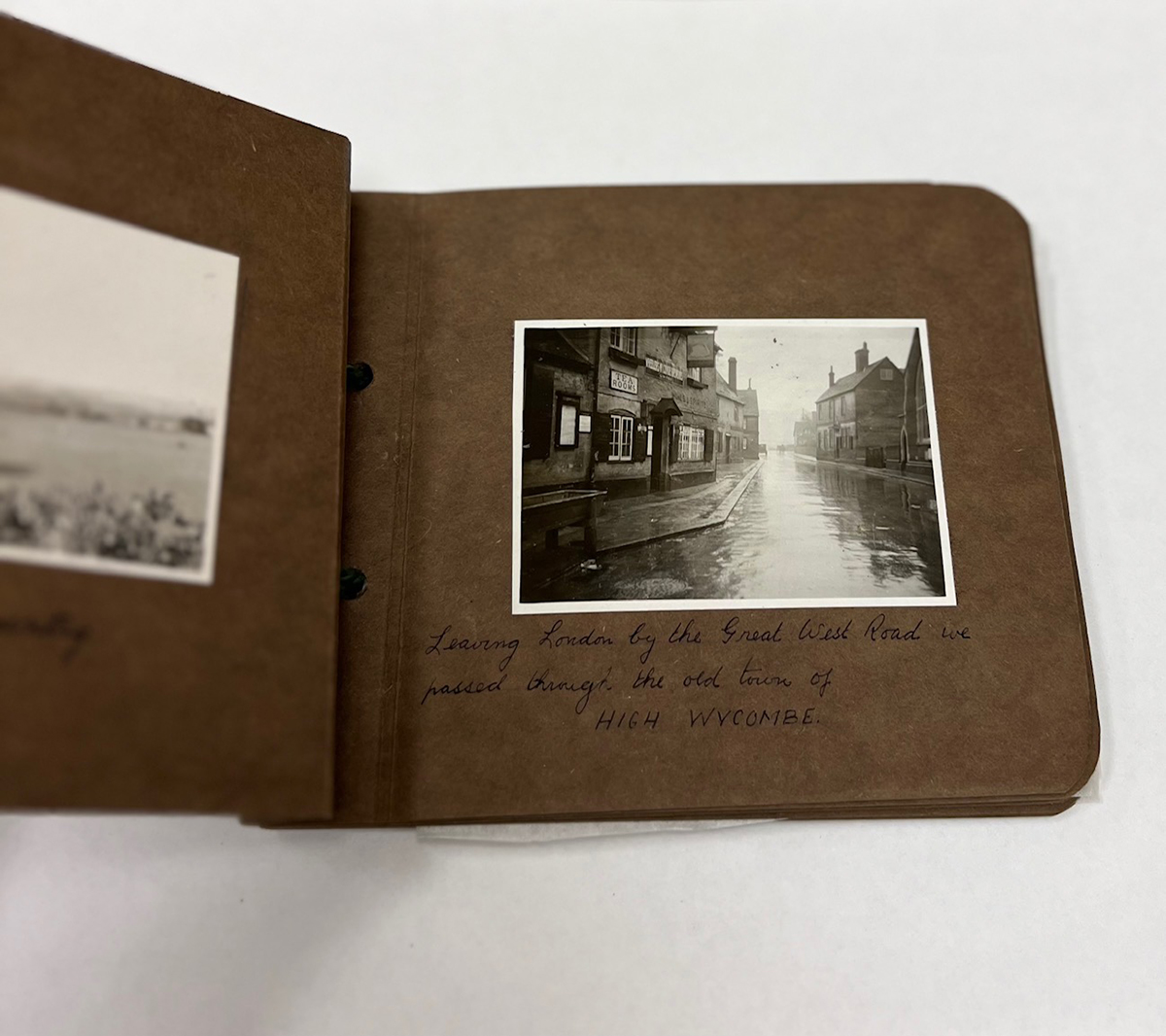
"The Cotswolds" Photograph Album, 1930. Accession 1, Box 106. / Image by Lauren Brady
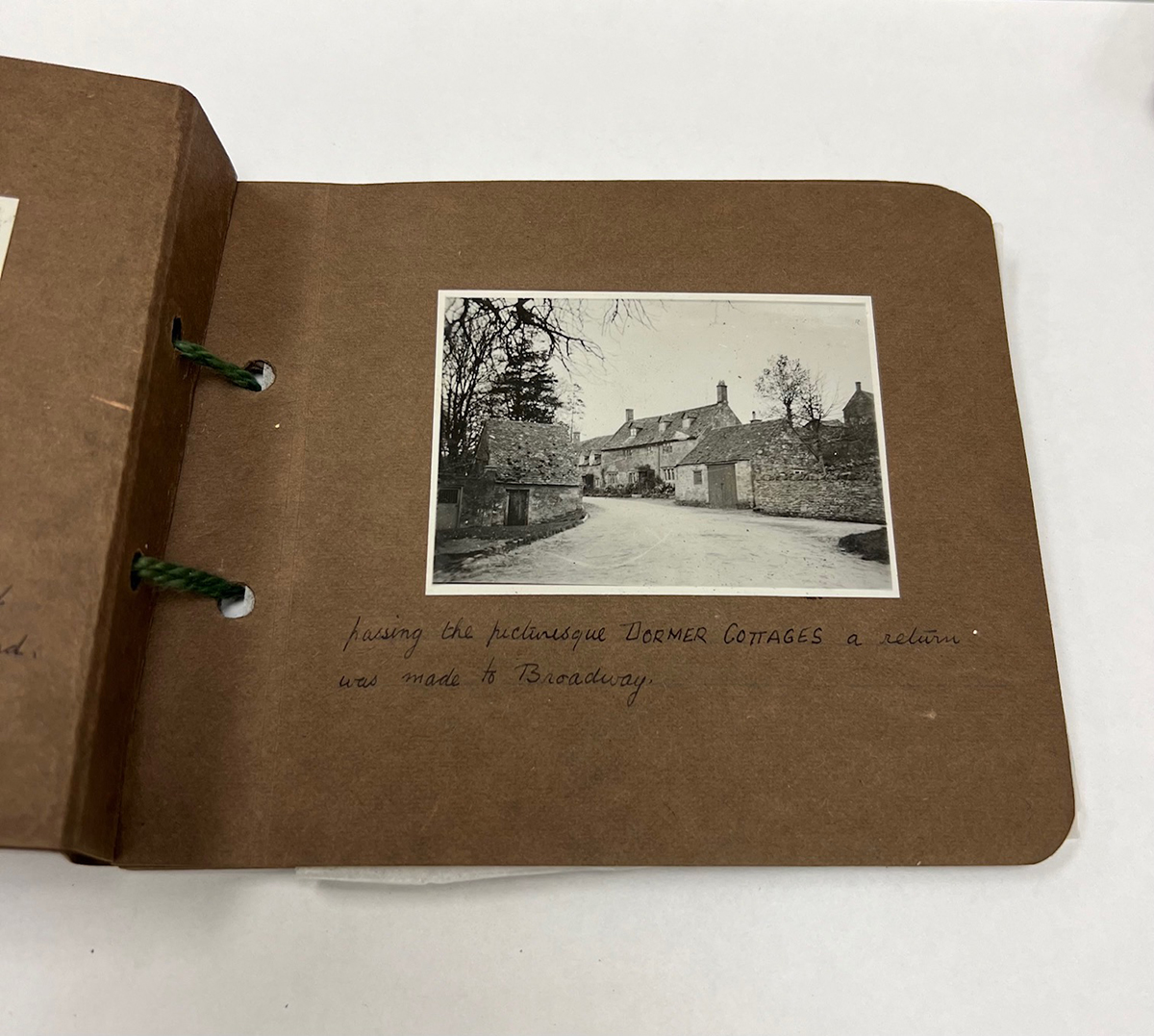
"The Cotswolds" Photograph Album, 1930. Accession 1, Box 106. / Image by Lauren Brady
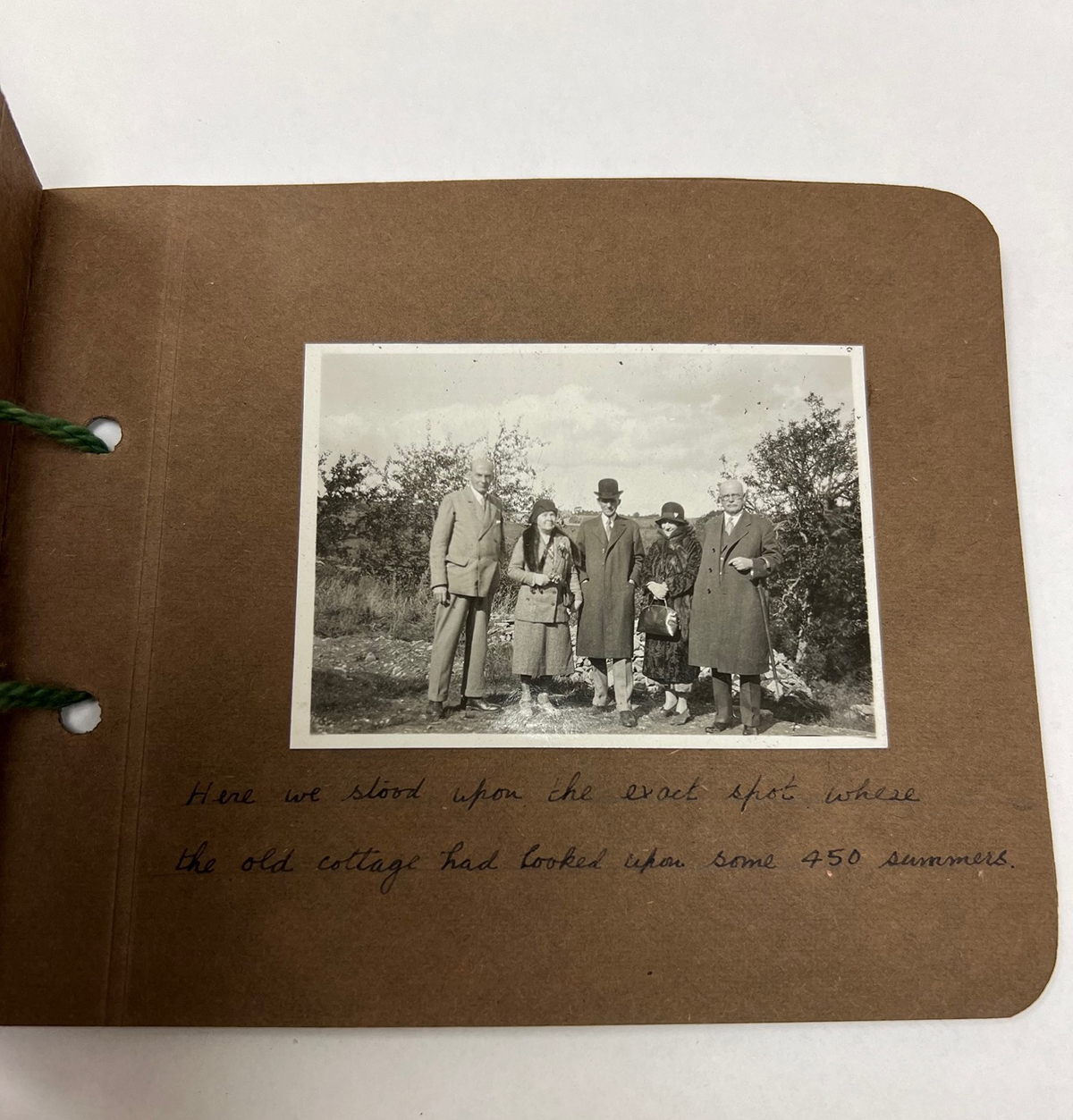
"The Cotswolds" Photograph Album, 1930. Accession 1, Box 106. / Image by Lauren Brady
Clara's diary entries with descriptions of cities and historic sites she encountered are valuable to historians looking for written records of landscapes altered by wars and other major events. Her words help us understand Clara Ford as a historical figure, but they also help us understand a location as it stood at that moment in time.
We are grateful to have these valuable archival records, but it is fun to wonder how a modern Clara may have documented her travels. Perhaps a post like this...
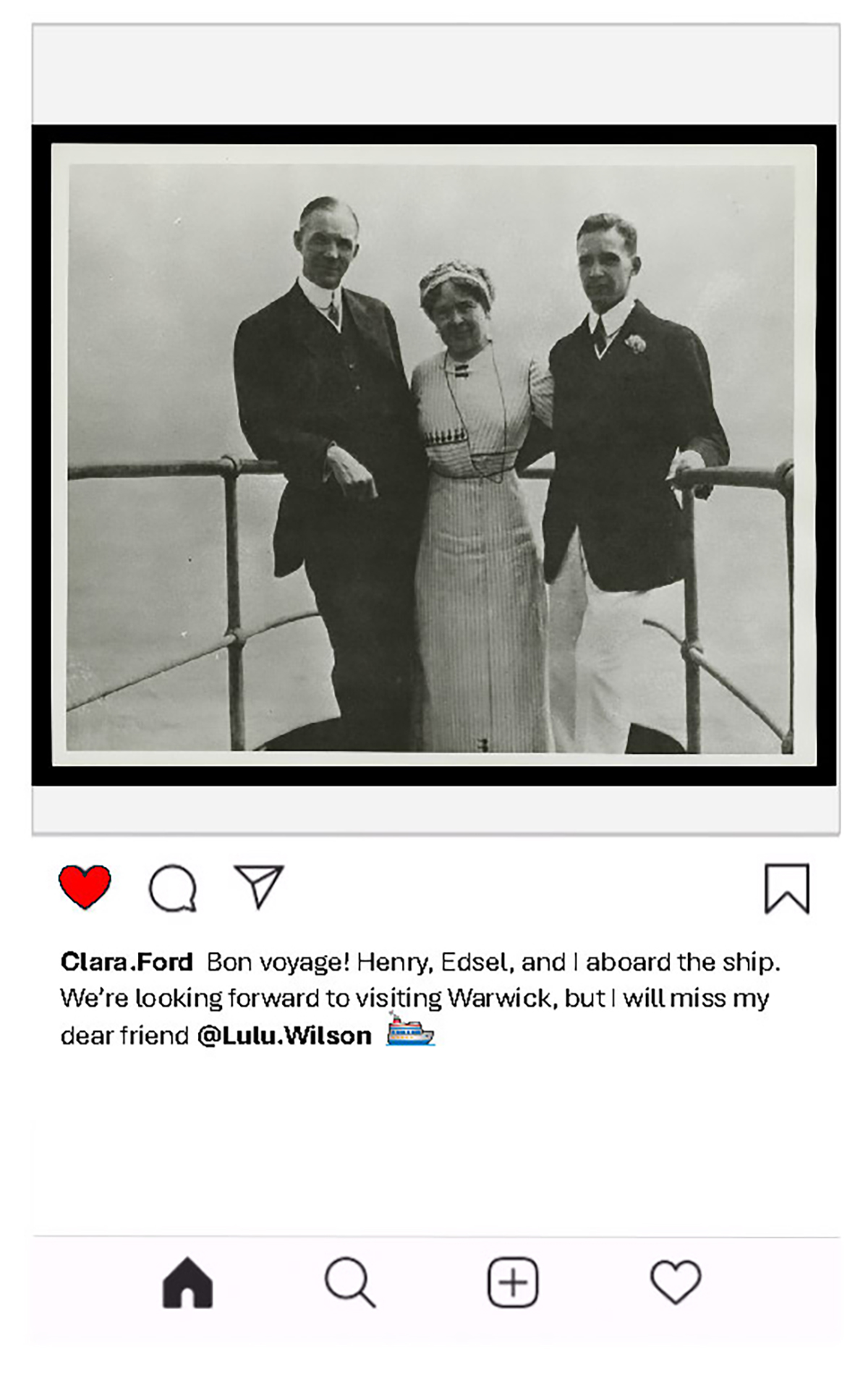
If you have any questions or would like to learn more about our collections, please contact the Benson Ford Research Center at research.center@thehenryford.org.
Lauren Brady is a reference archivist at The Henry Ford.
Edsel Ford, Ford family, Henry Ford, Clara Ford, by Lauren Brady
Spotlight on Master Presenter Cindy Melotti

Cooking in the Ford Home. / Photo by Ken Giorlando
Cindy Melotti is currently master presenter and house lead at the Ford Home, which is often considered to be the intellectual center of Greenfield Village. I had the honor of working alongside her in the Ford Home and Daggett Farmhouse in 2012. Cindy captivates guests with her energetic and authentic storytelling, and I’m delighted to chat with her about 17 years of adventures at The Henry Ford.
What did you do before you worked at The Henry Ford? And why were you interested in working here?
I worked at Wyandotte Public Schools as an elementary school teacher for 35 years, mostly in the upper elementary grades. Not surprisingly, I taught language arts and social studies. It was interesting in that we didn't really use textbooks. We, like Henry Ford, thought history should not be just about memorizing generals, dates, and wars. So I taught my social studies classes in a more contextual way. We learned about people in the times that they lived, and how they lived, not just timelines and titles.
I had always wanted to work at The Henry Ford. After retiring from Wyandotte Public Schools and taking a couple years to think about it, I decided that I was going to try and get a job here. So I went to a job fair. I didn't even tell my husband and my family that I was going, because I was afraid I wouldn't be accepted. This was actually the first time I wrote a resume. And it was the first time I applied for a job since I got my teaching position, which was when Lyndon Baines Johnson was president! I was as scared as a 16-year-old sitting there waiting to be interviewed. Despite there not being any historical presenter positions open, [The Henry Ford staffer] Mike Moseley recognized that I had the potential to be a good presenter. Thankfully, I got an interview with Cathy Cwiek, our former manager of domestic life. I got the job and was in training within a week.
Preparing food at Edison Homestead. / Photo by Ken Giorlando
Do you have any highlights of your teaching career or adventurous experiences that you’d like to share?
Well, a person of my age very typically followed the dictates of society at that time. I always wanted to be a teacher. I was fortunate to be able to go to Wayne State University. My parents were a one-income family, and we didn’t have a whole lot of money. So I considered myself lucky that I got hired by the school district where I student taught. I worked there for 35 years.
The brightest highlights for me are the memories of the children and their families. Some I still associate with and frequently talk to. I am still delighted to find out that I had a really big impact on a former student’s life. Once I became friends with a woman whose best friend from college remembered me from the fourth grade. She said that her friend had broken her arm near the start of the year, so she wasn’t able to write. This student was already ashamed of her handwriting, as she had been previously criticized in another class. She was telling our mutual friend that she had been so tense about this issue. And she said that I saved her life by suggesting she use a typewriter!
After all this time, this former student was so encouraged by my advice, she was still talking about it as an adult to her best friend. To think that I made that much difference in this this child's life! It was so wonderful that this story got back to me.
And in another instance on Facebook, one woman made a comment to me: “I just wanted to let you know that you were the most important teacher I ever had.” Never would I have expected that. It's amazing. Now, it was hard work. It was a lot of fun, and I enjoyed myself, but I never really thought about the impact I had on people's whole lives.
But those are the kind of things when you asked about adventurous experiences, that was the adventure. I guess the adventure was working with people and hopefully making an impact on their lives and making their lives better—making them better to fit their lives.
And of course, there's part of that that goes into presenting at The Henry Ford too. Because every guest that you interact with, you want their experience to make a difference. You want them to be different and more open to our stories when they leave, than when they came in.
Which historic homes and what programs have you worked at?
When I started in 2005, everyone in domestic life started at Daggett Farm. You also worked in uniform at the Noah Webster Home, Hermitage Slave Quarters, and the Mattox [Family] Home. You had to work your way into the Susquehanna Plantation and the Adams [Family Home]. Well, I never quite got to do that before they made me the house lead at the Ford Home, which was I think was 2007–2008. I eventually presented at Susquehanna Plantation. As I became a master presenter, they could schedule me in any home, really. I always wanted to work at Adams House, and I never got in there before it was closed for renovation. I can work at Firestone Farmhouse. And I’ve worked at the Edison Homestead.
I’m trying to think of the clothes I have in my closet, which period clothes are hanging there? So, it's Daggett, Edison, Ford Home, and Firestone, which are the buildings where we dress in period clothing. And then I wore the field uniform at Webster, Hermitage, and Mattox. I have also worked on a number of programs with the Henry Ford Academy.
Preparing food at Daggett Farm. / Photo by Ken Giorlando
What is your favorite home to work in?
I've been house lead at the Ford Home for over 10 years, so that’s a contender. I’ll always love Daggett Farm, and I’ll always say, once a Daggetteer, always a Daggetteer. But I really can’t say what my favorite building is.
Now with the Ford Home, people think it's strange when I'm elsewhere in the village besides the Ford Home. I'm like a fence post almost. I put in a lot of work at that house when they made me the lead, and I’m seen here most often.
The Ford Home was categorized differently over the years. It was part of the Ford Motor Company group when I started as a presenter. And then it went to the domestic life group. So the story of the home needed a little extra attention by then. We needed to work on the stories, and make sure they were authentic and correct. So that's when Cathy Cwiek asked me to upgrade the presentation at the building.
For about three or four years, anyone who presented there, if they were asked a question that wasn't in the manual, we wrote it down and researched it. That's why the manual is now very thick. Because when guests go into the Ford Home, they're not just asking about Henry Ford growing up in the house. There are so many different aspects of that house that are asked about and you want to be able to answer. Ford Home certainly demands a lot of work. But as much as I love Daggett, I really cannot pick a favorite.
Front of Ford Home. / Photo by Ken Giorlando
What is the relevance of the Ford Home within the village? I’ve considered it to be the intellectual center. Do you see it this way as well?
Well as Cathy Cwiek said when I became the house lead, the Ford Home is the cornerstone of the village. We needed to tell a more full story. We really want to have the best stories told there. In one perspective, Henry Ford restored and saved his childhood home to memorialize his beloved mother. His home played a big role in eventually developing the village and the museum itself.
And then there’s the perspective that you have this space that when you sit in it, you must realize the brilliant ideas that bounced off those walls from a little boy who eventually used those ideas to change the world. And when you think of that, it's awe-inspiring. The key for every presenter in any home is that it isn't about the house—it's about the people who lived in it and their ideas.
Presenters only have so much time to try and tell these stories as guests go through the house. You just never know what's going to interest the guests as they come in. You must have your background and information ready for basically any question. Plus, in many cases, the Ford Home is the first house that our guests visit. As they enter the village, they either go to the left to Firestone Farm, or they go to the right to the Ford Home.
A good presentation can set the tone for every guest’s entire day, especially for those who have never been here before. They’re not always aware of the scope of our campus. They might say: I have an hour, what should I see? In many ways, we are the ambassadors for the whole village at that point, and we can set the tone for an international guest or someone from out of state. We can set the tone for their whole day. We want to make sure the tone is one of positiveness, curiosity, interest, and amazement of the stories we have to share.
I know you have a lot of favorite stories about what you most like about working here, but perhaps you can pick one right off the top of your head?
If I can pick out a little snapshot, it would be during Holiday Nights [in Greenfield Village] in the Ford Home. I was in the dining room in the back, and a three-generation family came in. They were in the parlor up front where we've got the tree up with music and lighting, and I'm listening to their 10-year-old boy who’s giving my presentation! And he is spot on!
When the family came through the house to me, I said to the boy: “wow, you really did a good job telling our story.” He said: “of course, I was here on a field trip this year.” I love to tell this story because despite this kid having access to all the bells and whistles of electronics and technology—this kid learned it from our field trip program. I’m proud to say we’re still reaching an audience and, yes, we have a future and a purpose. This little boy is telling the story, and his whole family is interested.
There are so many instances when I’m very happy to see guests leave the building with a look as if they’re saying: “wow, I need to think about this.” I try my best to encourage them to understand that, as much of what we thought was true in history, there are preconceptions that aren’t always true, and you need to think in terms of the time and the setting of the place to understand what was going on.
This leads me to my cheese straw story. Before it was closed for renovation, the Adams House made these cheese straws, which were a specific recipe for that house. They could not be made at the Ford Home. When they closed Adams, we were now able to make them at the Ford Home. I had heard how good these cheese straws were and I was excited. We made the first batch, and after they came out of the oven, we just kind of sat there and looked at them. They were these flat, long things. I thought they were going to turn out puffier. They didn't rise at all. We realized that they were named, not after a modern sipping straw, but after actual straw from a field. We were completely off the mark.
When we look back at history, we need to ask ourselves: if my modern perception doesn’t allow me to understand what a cheese straw was, how can I use my modern perception to say, understand our Civil War? How do we understand a single event back then when we’re looking through our modern eyes and not going further? We encourage that “aha” moment that opens your mind for the stories that are accurate, instead of stories based in preconceptions or fantasy.
Spinning wool at Daggett Farm. / Photo by Ken Giorlando
What skills have you picked up and learned how to do and demonstrate at the village?
Well, there are textile skills like carding, spinning, and dying wool that I’ve done at Daggett. I did do some weaving on the big old colonial loom when that was set up inside Daggett. But I only had a little experience on that because I was so short. I had to jump down to change the bottom pedals, so it would take me an awfully long time. But I did work successfully on the treadle wheel that you pump with your foot. That's very difficult to do, as I was spinning with linen. Linen is a whole different process compared to wool.
Also, during the first year I was here, we had candle dipping over in the Liberty Craftworks area, near where the Davidson-Gerson Gallery of Glass is now. We wore field uniforms. We were considering it to be a craft at the time, as opposed to it being part of a culture or time period. That was my first experience with it. Candle dipping was a lot cooler in period clothing and more fun to set up under the trees next to Daggett or the [William Holmes] McGuffey Birthplace, where the activity fit with the history of the building.
Screenshot of 1876 centennial program at the Ford Home for WDIV.
Along with this WDIV segment, and a previous video promoting Fall Flavor making an 1860s apple cake, you were most recently involved in a video celebrating the Fourth of July in 1876 outside the Ford Home recorded during the pandemic. Could you tell us how this came about?
Yes, it was 2020 during COVID, and we were unable to host Salute to America. Over the years, we had developed a Fourth of July program specifically for the 1876 centennial at the Ford Home. And I was asked if I could do a video presentation of this program. I didn’t know what the filming was for at the time. I thought it was for a kind of video that we do for in-house purposes.
We filmed this on June 16. We didn't open the village up until July 2. And I came in early to work to do the video. It was basically a sample of the program we would do for a Fourth of July holiday at the Ford Home—a few of the games and the food that we’d make. So it was fun.
It wasn't until after filming that I learned that this was not being used for our website. I learned that it was for a WDIV Fourth of July virtual celebration! It was a surprise for sure, but we are presenters. And just because there's a camera there doesn't change the energy and information you give. You know, it's what we do.
So WDIV aired this the following Friday night at 8 p.m., and they broadcast snippets of the Detroit Symphony Orchestra playing, along with my Ford Home centennial program. It was hosted by Tati Amare, who I met previously. Of course, they filmed theirs, and I filmed mine, and it was only on television that we met, so I couldn't say hello again. But they pieced it all together as a virtual presentation for the holiday on WDIV. I was honored to be a part of it.
So you’ve been in many pictures and videos. Can you think of any other fun or unusual stories regarding getting your picture taken?
When I was going through training in 2005, and we needed to sign the waiver to give permission for The Henry Ford to use our photographs, guess who said: “why would anybody want to take my picture?” Ironically, my picture has been in so many places. It’s been amazing. I knew within a month that I asked this that I had made a silly statement, because I realized that guests are taking our pictures all the time and sending them all over the world. Presenters are world travelers in that way.
I remember presenting at Edison Homestead one day during our noon meal, and an Asian guest came in and he wanted his picture taken with us. We handed him a cup to hold, to make it look like he was having a meal with us. A young couple also came in and they graciously took this photo of us. I turned to the gentleman and asked where our picture was going. And he said it was going to Beijing, China. Well, I didn't want the young couple to feel left out, so I asked where they were visiting from. The young man said Wyandotte, Michigan—and then he said that I had been his teacher! This is the experience of presenter. You can have a visitor from Beijing, China, and also someone that you knew years before in your classroom. Like, how does this happen?
Barney Litogot in 1865. / THF226856
Did you have any experiences at the Ford Home of guests reaffirming stories of Henry Ford’s life? Any other surprising interactions with guests?
When I first started working at the Ford Home around 2007, I used to get guests who had firsthand memories of the Fords, just little stories. People who had funny interactions with the Ford family, for instance, neighborhood kids who would be playing on the farm, when it was in its original location, and they’d get caught.
I remember there was an elderly man who would take walks in the village in the morning, and he told me once that he used to drive by the Ford Home every day on his way to work when it was located on Ford Road. And sometimes he’d see Henry Ford walking around. He’d be picking vegetables and fruits to put in baskets that would be placed on the porches of neighbors who didn’t have enough food. I heard stories like that all the time. But all of a sudden, kind of recently, I realized those guests are gone, that generation is gone.
So the guest in 2009 who was 78 years old when he told me this story about getting caught by Henry Ford—he said it was actually his brother's fault. He also told me about the time the Ford family was moving the house to the village, and he got on his bike and followed it down the road. I have a pile of stories that were told to me. You come to think that after hearing the same story over and over again, that there is truth to them, and that's exciting.
I have at least twice had guests tell me stories that I've read in my research, which is amazing. There’s the story of the Vagabonds—Henry Ford, Thomas Edison, Harvey Firestone, and John Burroughs—when they were driving around Kentucky or Tennessee. There were no roads, so they had to follow river beds and try to find open areas to drive. They were scouting and looking for forests and sources of wood, because they needed wood to build Model Ts. Henry Ford owned many forested areas for that purpose.
And to paraphrase a story, the Vagabonds were driving through the wilderness, and their car got stuck. A farmer came by and used his horse to get them out. As the story goes in the research that we have in our Ford Home manual, Henry Ford introduces himself to the farmer. Thomas Edison introduces himself to the farmer. Harvey Firestone was there, and he introduces himself. And then John Burroughs who has this long white beard, right? He says: “well, you know, if you want to believe those guys then you can believe I’m Santa Claus!” Now, there are other ways people have told this story, of course.
Back to the Ford Home, I’m presenting and there's a three-generation family who comes in and we're talking about the house and the history, and the man said: I have a Ford story. He said: “my great grandfather had one of the first Ford dealerships (around Kentucky or Tennessee) and my grandfather told me the story about how Ford and his friends got stuck in a riverbed and one of our local farmers with horses pulled them out.”
The guest went on to explain that it wasn't long after this incident happened that a Ford tractor was delivered to the dealership to be given to the farmer who had helped them out. Isn't that amazing? I was delighted then to tell him and his family about the Vagabonds introducing themselves to the farmer. So where else could you ever present where you hear a direct story from a family that you had read about in a book as part of your research? You know, what's not to like about that?
One of the most emotionally powerful days I ever worked in the Ford Home was on the 150th anniversary of Abraham Lincoln's death. In the museum, they took Lincoln’s chair out and put it up on a platform behind the cornerstone. Unfortunately, I didn’t get to see it. However, there is a connection to Lincoln's death at the Ford Home. We have a photo in the sitting room of Barney Litogot, Henry Ford’s uncle on his mother, Mary Litogot’s, side. Barney was in the 24th Michigan Volunteer Infantry, part of the famed “Iron Brigade,” serving as an honor guard on the train carrying Lincoln to his final resting site in Springfield, Illinois.
I told Barney’s story to the guests who had already been to the museum and seen the chair. I really wish that I could have had a camera taking pictures of people’s expressions, because they were so moved, even crying. The museum exhibit, along with Barney’s story, was so emotional. It was just so special to be a part of that immediate tie-in to that event in our country's history, and I don't know that you could have felt too much closer. Presenting an artifact, a story, an emotion—that is what we do best.
I really love the story of Barney, and I’ve visited his burial site at Sandhill Cemetery on Telegraph Road near the I-75 ramp in Taylor, Michigan. And I always wave as I drive by and say: “hi, Barney”!
Yes, I do too! My husband doesn’t even think I’m weird anymore, he’s used to it! I always say hi to Barney. Speaking of the Litogots, the Litogot family had a reunion in the village a few years ago. They visited the Ford Home, and I got to talk to them for about 10–15 minutes. And they were talking about Uncle Barney as he was a true part of their family. It was really cool. You just never know who's going to walk through the door.
I've had fun remembering all these stories and experiences, and it's really hard to rank anything when you've been doing it for so long. But every experience and interaction deals with a relationship with guests and co-workers, and that's where the good stuff comes from. When you look over everything that goes on at The Henry Ford, it's a wonderful job, and it's why people get hooked.
Amy Nasir is Digital Marketing Specialist and former Historical Presenter in Greenfield Village at The Henry Ford.
nature, 1940s, 1930s, 1920s, philanthropy, national parks, Ford family, Edsel Ford, digital collections, by Ellice Engdahl
Edsel Ford and the National Park Service: Part 3
Great Smoky Mountains and Shenandoah
During his 1927 summer retreat to Seal Harbor, Maine, Edsel Ford spent time having discussions with his neighbor John D. Rockefeller Jr. on the importance of the national parks to the American public. One year before, in 1926, Arno B. Cammerer, then Associate Director of the National Park Service, had initiated his career-defining project of establishing numerous national parks in the Eastern United States when Congress authorized the National Park Service's Great Smoky Mountains and Shenandoah park proposals. At the time, Lafayette National Park, now Acadia National Park, was the only park east of the Mississippi and despite growing travel to western parks, Cammerer was concerned that only a very small portion of those living east of the Mississippi would ever have the time or the money to visit them.
Realizing that there were millions of people in "the congested areas of the East who never will see the western parks," Cammerer helped the National Park Service establish an unofficial commission composed of park experts to ascertain whether there were lands in the East that would meet the National Park Service standards. The commission, partly funded by John D. Rockefeller Jr., focused on the Southern Appalachian Mountain region, concluding that the lands that would eventually make up the Great Smoky Mountains National Park and Shenandoah National Park should be set aside for the American public. West of the Mississippi, parks could be easily carved out of large public land holdings. In the East, however, a majority of land was privately held which meant that although these Eastern park projects had been authorized in 1926, they could not be fully established until a majority of the land in the planned areas had been bought by the state and deeded to the U.S. government. Cammerer soon realized that land purchasing financed by state funding and small public donations would not be enough to make the Eastern park project a reality.

Several popular tourist stops in the Great Smoky Mountains National Park appear on this pennant. THF238700
To remedy the funding problem, Cammerer again turned to one of the wealthiest men in America and the largest benefactor of the East's first national park, John D. Rockefeller Jr. After helping to fund the commission, Rockefeller Jr. had previously mentioned to Cammerer that he was very much interested in continuing his support of the Eastern national parks project. This prompted Cammerer to write him in the beginning of August 1927 at Rockefeller Jr.'s Seal Harbor home, "The Eyrie." Cammerer's letter explained that while he had intended for public donations to be split fifty-fifty between the Great Smoky Mountain project and the Shenandoah project, the Great Smoky Mountains project was further along and more time-sensitive, as some of the lands set aside for the project were being clear-cut of their primitive forests before being sold. Securing the land for the Great Smoky Mountains project had become the utmost priority.
Expressing that the potential Great Smoky Mountains park “appeals to him more than any national park," Cammerer also enclosed photographs in his letter that he thought illustrated the “wonderful scenic character of the country proposed for inclusion in the park.” In Seal Harbor, Rockefeller Jr. brought the issue to the attention of his philanthropic partner, neighbor, and avid photographer, Edsel Ford. Sparking an interest with Edsel to contribute to the project, Rockefeller Jr. relayed to Cammerer that Edsel would possibly be willing to donate, spurring Cammerer to contact Edsel in the beginning of September 1927. In his letter to Edsel, Cammerer added, “I am taking the liberty to enclose a considerable number of photographs showing the superb scenic qualities of the region, which Mr. Rockefeller also has seen, which I believe Mrs. Ford and you will enjoy looking over."
Over the course of September 1927, Cammerer kept sending Edsel information on the Eastern parks project, reiterating that the Great Smoky Mountains park in Tennessee and North Carolina continued to be the top priority. He also explained that the land required for the Shenandoah park consisted of mostly Virginian farmland and would take much longer to acquire. Luckily, the proposed Shenandoah park would include part of the Shenandoah Valley, which happened to be the birthplace of Harry F. Byrd, the Governor of Virginia at the time. The son of a wealthy apple grower from the Shenandoah Valley, Governor Byrd supported the idea of establishing a national park in his state and worked to make it a reality. Governor Byrd's brother, Admiral Richard E. Byrd, also happened to be a world-renowned explorer, pioneering aviator, and friend of Edsel Ford. Edsel would be responsible for helping to fund Richard Byrd's expeditions to the Arctic and Antarctic, including convincing Rockefeller Jr. to aid in funding the latter.

Running the entire length of Shenandoah National Park, Skyline Drive offers 105 miles of scenic views along the Shenandoah Blue Ridge. This souvenir pennant depicts the 670-foot-long Mary's Rock Tunnel -- the only tunnel on the drive. THF239213
Rockefeller Jr. wrote Edsel from Seal Harbor at the end of September looking for a decision, noting that the Great Smoky Mountains project still needed money to purchase land and that Edsel had “expressed an interest in this project" when Rockefeller Jr. saw him in Seal Harbor a few weeks ago. Rockefeller sent him a copy of his pledge hoping that his letter of gift might be suggestive to the amount of money Edsel would donate. Edsel responded the same day saying, "I feel like I would like to help in this great undertaking," but financial obligations like a new home and other philanthropic efforts required him to donate "less than I would like to do if the circumstances were otherwise." Nonetheless, Edsel was "very glad to contribute $50,000 dollars" to the Great Smoky Mountains project and also would "be very glad to consider increasing" the pledge the next year if additional funds were needed.

In this letter from Edsel Ford to Rockefeller Jr., Edsel mentions his various other philanthropic activities, including an explanation on how important Richard Byrd's South Pole expedition will be. Due to Edsel's convincing justification above, Rockefeller Jr. would later help fund Byrd's expedition. THF255218
On October 6th, referring to their new partnership in funding the Great Smoky Mountains National Park, Rockefeller Jr. wrote Edsel saying, “It is particularly gratifying to me that we are to be associated together with it." By November of 1927, Edsel had contacted Cammerer to declare that he intended to subscribe $50,000 to help establish the Great Smoky Mountains National Park, which Cammerer graciously accepted. In February 1928 though, the Great Smoky Mountains project hit delays. Lagging fundraising meant that the lands designated for the park, which had yet to be acquired, were still under constant threat of being logged and needed to be procured immediately. The only public pledges to the park had been the ones made by Edsel and Rockefeller Jr. For the park to go forward, five million dollars would need to be raised in order to match the five million dollars in state funds already set aside to buy land for the park. With Edsel's pledge of $50,000 and Rockefeller Jr.'s pledge of $1,000,000, they had fallen well short of that goal.

Edsel Ford's signed letter to Arno B. Cammerer, stating that he is interested in contributing to the Great Smoky Mountains National Park project that Rockefeller Jr. had brought to his attention. THF255210
With time being of the essence, Rockefeller Jr. wrote Edsel with his proposed solution to the problem. The trustees of the Laura Spelman Rockefeller Memorial, a fund established by Rockefeller Jr.'s father in memory of his mother and headed by Rockefeller Jr., decided that an enterprise of this kind would have made a "very strong appeal" to Mrs. Rockefeller. The foundation would cover the entire five million dollars needed to match the state funds, helping to acquire all of the land needed to establish the Great Smoky Mountains National Park. With the total cost covered for the first park, Rockefeller Jr. suggested that Edsel transfer his donation over to the Shenandoah project, to which Edsel obliged.

While Edsel admitted that he had not taken a deeper look into the Shenandoah National Park project, he did accompany his family on a 1921 camping trip to the Blue Ridge Mountains of Maryland, a location less than hundred miles north of Shenandoah and geographically similar. Possible memories from this trip could have also played a role in Edsel's decision to donate to Shenandoah. THF255214
On February 28th, 1928, Edsel withdrew his pledge to the Great Smoky Mountains National Park and promptly informed Cammerer that he would be transferring the same pledge over to the Shenandoah National Park fund. Rockefeller Jr. sent a letter thanking Edsel for his understanding and the transfer, ending the note with, “Looking forward to the reunion of our summer colony at Seal Harbor.” Cammerer also sent a letter thanking Edsel for his cooperation, noting, "There is nothing finer available in the East than these two areas selected for national park establishment and this is the psychological time, as the history of our country goes, to still procure these outstanding scenic beauty spots for the millions who will not have a chance to see the western wonderlands reserved in the national park system." Rockefeller Jr. would also contribute to the Shenandoah National Park fund as well.

This letter illustrates the pivotal role that Seal Harbor, Maine played in the friendship of Rockefeller Jr. and Edsel Ford. THF255212
In 1932, the state of Virginia began to collect the pledges that had been made to the Shenandoah National Park fund. Edsel reaffirmed his interest in this philanthropic endeavor with a letter to the Governor of Virginia saying, "It has been a great pleasure to contribute" to the fund. By 1935, Shenandoah had officially been established as a national park and, in 1936, they held a dedication ceremony to which Edsel was invited. Unfortunately, Edsel was leaving for Europe soon, which he explained to Cammerer, but his good friend Rockefeller Jr. was able to send a transcript of the dedication speech given by Secretary of the Interior Harold Ickes. Part of the speech thanked Edsel for his contribution.
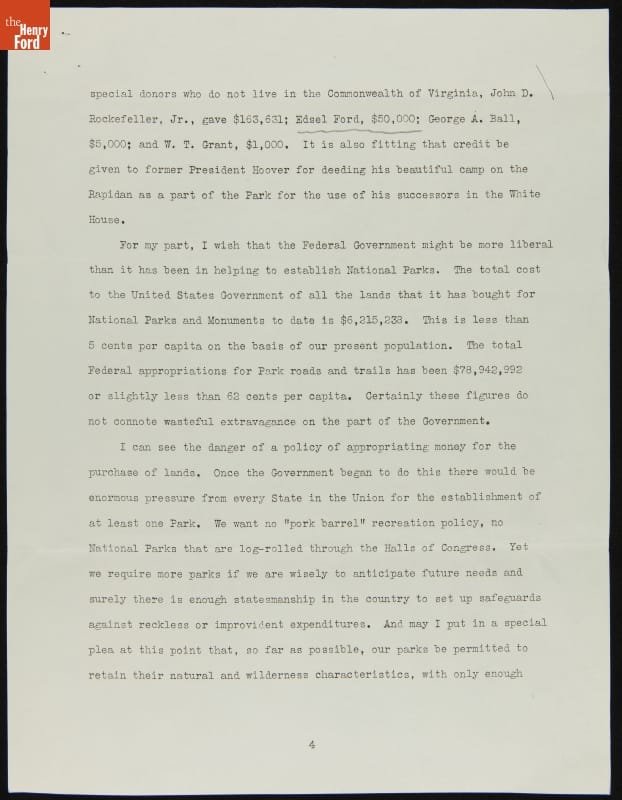
A page from Harold L. Ickes' Shenandoah National Park dedication speech. Named Secretary of the Interior by Franklin D. Roosevelt, Ickes held the position for thirteen years from 1933 to 1946. Known for being brutally honest, tough, and sharp-tongued, Ickes worked with Arno B. Cammerer to dramatically increase national park land even though the two constantly quarreled. THF255228
Ryan Jelso is Associate Curator, Digital Content, at The Henry Ford.
North Carolina, Virginia, philanthropy, nature, national parks, Ford family, Edsel Ford, by Ryan Jelso, 20th century, 1930s, 1920s
Edsel Ford and the National Park Service: Part 2
Part 2: Mount Desert Island, Maine
Located off the coast of Maine, Mount Desert Island is one of the largest islands in the United States and home to Acadia National Park. Long known for its rocky coast, mountainous terrain, and dense wilderness, Mount Desert Island was popularized in the mid-19th century by the Hudson River School. The painters from this art movement focused on scenic landscape paintings, creating works of art that inspired many prominent citizens from the East Coast to build their summer homes on the island. By the late 19th century a resort tradition that became locally known as "rusticating" had taken root on Mount Desert. Wealthy East Coast families known as "rusticators" would spend their summers relaxing in their island mansions, taking in the scenery, and socializing with other prosperous families doing the same. In the early 20th century, the "rusticators" on Mount Desert Island also began to include affluent Detroit families as well.
Eleanor Lowthian Clay, Edsel Ford's future wife, was accustomed to affluence and spent her summers vacationing on Mount Desert Island as a child. Eleanor's wealthy uncle, Joseph Lowthian Hudson, was successful in the Detroit department store scene. As patriarch of the family, the childless J.L. Hudson cared for his other family members and allowed Eleanor's family, as well as some of his other nieces and nephews, to live with him. Hudson employed most of them in his business and groomed his four Webber nephews, Eleanor's cousins, to take over the family trade. Their sister, Louise Webber, married Roscoe B. Jackson, a business partner of J.L. Hudson. In 1909, Jackson helped formed the Hudson Motor Car Company with backing from Hudson. Jackson had found early success with the Hudson Motor Car Company and after inheriting the department store company, the Webber brothers were able to continue its success as well. The wealth and status that these families enjoyed allowed them to later choose Mount Desert Island as the location for their summer retreats and influenced Edsel to do the same.
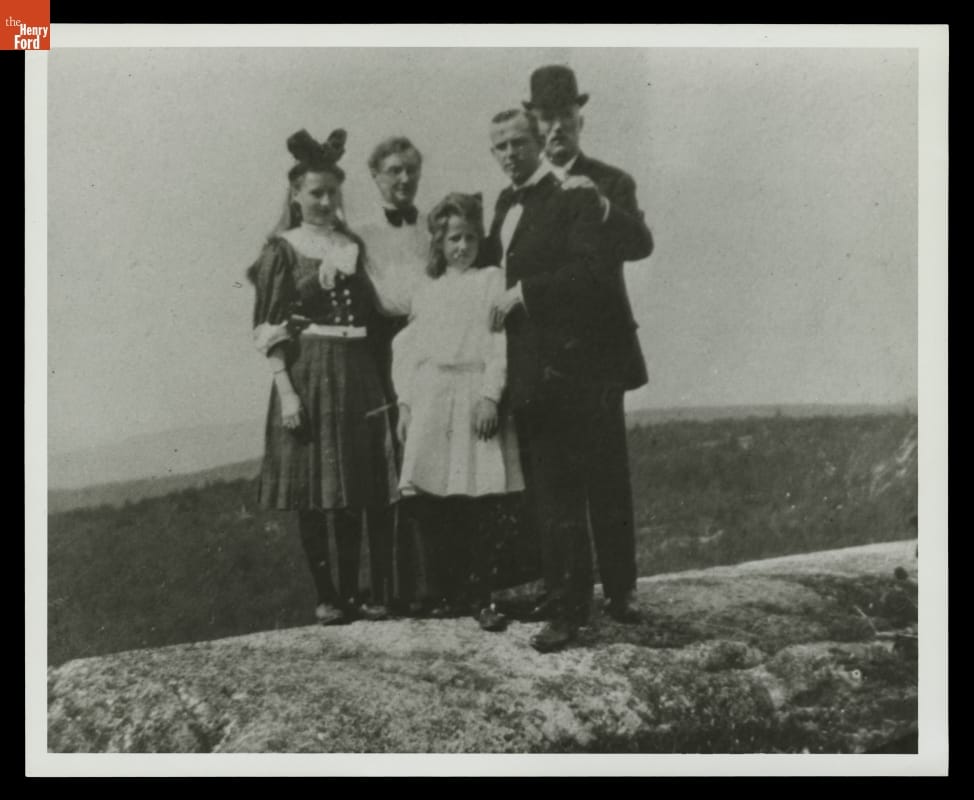
Eleanor, right, and her sister Josephine, left, vacationing in Maine with their family. THF130536
The wealth of J.L. Hudson had helped establish Eleanor's cousins and acquaint Eleanor with the son of another wealthy Detroiter in Edsel Ford. While Edsel courted Eleanor, her sister Josephine was simultaneously being courted by up-and-coming lawyer Ernest Kanzler. Edsel became close friends with Kanzler, his future brother-in-law, who eventually was hired by Henry Ford to help manage the Fordson tractor company. By the early 1920's, Edsel and Eleanor along with the Kanzlers, Webbers and Jacksons were all vacationing on Mount Desert Island. Edsel began his Mount Desert residency by renting summer homes there, occasionally inviting his parents to vacation with him. During the late summer or early fall of 1922, Edsel purchased property in the area known as Seal Harbor. Sitting 350 feet above sea level on what is known as Ox Hill, Edsel's property had a panoramic view of the surrounding sea and sky. Also within walking distance of Acadia, then Lafayette National Park, Edsel soon found that his property adjoined the property of the neighborhood national park's biggest benefactor, John D. Rockefeller Jr.

Edsel with his sons Henry II and Benson spending time at the beach in Seal Harbor. THF95355
Rockefeller Jr. first visited Mount Desert Island in 1908 and immediately became enamored with the area. He built a large estate in Seal Harbor and by the time he became neighbors with Edsel in 1922, Rockefeller Jr. had already used his wealth to donate large tracts of land to his local national park. During this time he was also in the process of building a network of carriage roads that allowed the beautiful vistas of Acadia to be accessed by the public. Preferring the quiet serenity of horse-drawn carriages over the noisy automobiles, Rockefeller Jr. worked personally with the engineers to ensure that the carriage roads captured the tranquil scenery the park had to offer. The beautiful landscapes of the area would become the topic that Rockefeller Jr. used to initiate his friendship with Edsel Ford.

Panoramic view of Seal Harbor located on Mount Desert Island, Maine. THF255236
Initially writing in December of 1922, Rockefeller Jr. didn't hide his feelings when congratulating Edsel on the purchase of his Seal Harbor property. He had visited Edsel's property at the top of Ox Hill during sunset one night and stated in his letter, "I do not know when I have seen a more magnificent and stunning view than that which met my eye on every side. You have certainly made no mistake in selecting a site for your home.” He concluded the letter by expressing how happy he and his family were at the thought of having Edsel as a permanent summer neighbor. In Edsel's gracious response to Rockefeller Jr., he mentioned that he would be using architect Duncan Candler to design his Seal Harbor home. Candler had previously designed the neighboring Rockefeller home, as well as other note-worthy properties on the island.

John D. Rockefeller Jr.'s initial letter to Edsel congratulating him on the purchase of Edsel's Seal Harbor property. This letter lead to a life-long friendship that would be fueled by the spirit of philanthropy. THF255332
Christened with the name "Skylands" due to the unbroken views of the Maine horizon line that the property provided, Edsel's summer retreat was built between 1923 and 1925. In 1924, familiar with his new summer neighbor's philanthropic efforts and swayed by his past experiences, Edsel began donating yearly to the National Parks Association, known today as the National Parks Conservation Association. Created by industrialist Stephen Mather in 1919, the organization's mission was to protect the fledgling National Park Service, of which Mather was the director. For eight years Edsel would donate $500 annually to the National Parks Association, until the Depression years of 1932 and 1933 when other business and philanthropic demands restrained his monetary donations.
By the time Edsel's summer home was done in 1925, he and Rockefeller Jr. had become good friends and philanthropic partners. They shared a love for the arts, beautiful scenery, social justice, and civic responsibility. Although twenty years his senior, Rockefeller Jr. found Edsel's situation relatable. Both men were the only sons of immensely wealthy industrialist fathers and both had inherited the responsibility of their massive family fortunes. Each looked to use those fortunes to serve humanity and steer society towards a positive future. Rockefeller Jr. cherished the trait of modesty, a trait that he saw Edsel strongly demonstrate throughout his life. For that reason, Rockefeller Jr. held Edsel, "in the highest regard and esteem," describing him as, "so modest and so simple in his own living and in his association with his fellow men." Their summers spent together at Seal Harbor would undoubtedly include conversations about where they could best direct their philanthropic efforts.
Ryan Jelso is Associate Curator, Digital Content, at The Henry Ford.
1920s, 20th century, philanthropy, nature, national parks, Ford family, Edsel Ford, by Ryan Jelso
Edsel Ford and the National Park Service
On August 25, 2016, the National Park Service celebrated its 100th birthday, a celebration that encouraged us to seek connections within our collections. This blog post is the first part of four that will trace Edsel Ford’s relationship to the national parks.
The landscapes preserved by the national parks are a source of inspiration. Not only do they document the natural history of America, but they are also integral in telling the story of humanity on the continent. They remain powerful educational tools, allowing citizens to reflect on their collective history and where they want society to go in the future. Responsible for protecting these historical, cultural, and scenic landscapes, the National Park Service owes much of its existence to the forward-thinking industrialists who supported the early environmental movements in America.
The National Park Service's birth can largely be attributed to the efforts of millionaire industrialist Stephen Mather. Using his wealth and political connections, Mather secured the job of Assistant to the Secretary of the Interior and went to Washington. Once there, he worked to lobby, fundraise, and promote an agency that could manage America's national parks and monuments. Finding success, Mather became the first director of the newly-formed National Park Service in 1916. At times, he even funded the agency's administration and bought land out of his own pocket. Mather was not the only affluent American to donate his time and wealth to the National Park Service.
The Rockefellers and Mellons, two of America's wealthiest families in the early 20th century, also became champions of the national parks. Specifically during this time period, the biggest player in national park philanthropic efforts was John D. Rockefeller Jr., the only son of oil magnate John D. Rockefeller. Among his many other National Park Service donations, Rockefeller Jr. was noteworthy for purchasing the land or donating the money that helped create the national parks of Acadia, Great Smoky Mountains, and Shenandoah, including the expansion of Grand Teton and Yosemite National Parks. Rockefeller dominated this philanthropic scene and ultimately influenced the only son of another wealthy industrialist to join him in his cause.
Edsel Ford, born to Henry and Clara Ford in 1893, was not born into wealth, but the success of Ford Motor Company in the early years of the 20th century led his father to become one of the richest men in America. This set Edsel down a path to inherit the responsibility of that wealth, a position in which he would thrive. Remarking that wealth "must be put to work helping people to help themselves," Edsel understood the elite position he was in and acted with grace throughout his life. Often described as altruistic, sensible, reserved and most importantly modest, Edsel would go on to channel his family's money into countless philanthropies including medical research, scientific exploration, the creative arts and America's national parks.

While this photograph was taken during the Fords' 1909 trip to Niagara Falls, they posed for the shot in a studio and were later edited into a photo of the falls. THF98007
At a young age, Edsel experienced some of the monuments and landscapes that make up our current national park system, creating memories that surely influenced him later in life. Family trips in 1907 and 1909 took Edsel to Niagara Falls, today a National Heritage Area in the park system. For the Alaska-Yukon-Pacific Exposition of 1909, Edsel accompanied his father by train to Denver and from there they took a scenic drive to Seattle where the exposition was being held. In 1914, he joined Thomas Edison, John Burroughs and his family as they spent time camping in the Florida Everglades. He also had the opportunity to visit the Grand Canyon at least four times in his life, with his first glimpse of the gorge occurring during a family trip to Southern California in 1906.

Visiting the Grand Canyon in 1906, Edsel sits here with his mother, Clara Ford, and Clara's mother, Martha Bryant. The canyon can be faintly seen in the background. THF255176
Edsel recorded a subsequent trip to the canyon in his diary during January of 1911. He wrote that he spent time hiking, visiting the Hopi House to watch Native American dances, and photographing the canyon. Photography would become one of many artistic hobbies Edsel pursued over the course of his life. Undoubtedly the beautiful vistas of the Grand Canyon provided a spark of creativity for the burgeoning young artist. The national parks and monuments had inspired creative sparks previously, allowing Edsel to illustrate this picture of the Washington Monument in 1909. These forays into the arts helped Edsel later become the creative force that took Ford Motor Company beyond the Model T and successfully into the industry of automobile design.

Edsel recorded his second Grand Canyon trip in his diary. Interestingly, Edsel also mentions he has heard of the deaths of Arch Hoxsey and John B. Moisant, two record-breaking pilots who died while performing separate air stunts on New Year's Eve of 1910. THF255172
Before Edsel made his dreams of car design a reality, Ford Motor Company had played a role in helping to improve accessibility to the landscapes of the national parks by making the automobile, specifically the Model T, affordable to the masses. In 1915, at age 21, Edsel took off in a Model T on a cross-country road trip with six of his friends. Departing from Detroit and heading to San Francisco, the trip allowed Edsel to again witness the scenic changes in the countryside as he traveled across the continent, something he had experienced on numerous family trips before. This time though, he was in charge of the places he explored. Making various stops during his expedition, Edsel visited the Rocky Mountains of Colorado, the desert of New Mexico and the Grand Canyon for a third time.

Edsel Ford and friends hike down Bright Angel Trail while visiting the Grand Canyon during their 1915 cross-country road trip. THF243915
The Grand Canyon must have left quite the impression on Edsel because, in November of 1916, he brought his new wife Eleanor Clay there on the way to their honeymoon in Hawaii. He wrote his parents from the El Tovar Hotel saying "We are surely having a great time. Walking and breathing this great air." They had spent the previous day visiting Grandview Point, a spot that continues to provide park goers with breathtaking views of the canyon. Edsel's new wife Eleanor would play an important role in his future national park endeavors. She exposed him to the rugged shores and natural beauty of the Maine coast -- a place where Edsel would cross paths with John D. Rockefeller Jr., establishing a friendship that would last a lifetime.

Operated by the Fred Harvey Company, which owned a chain of railroad restaurants and hotels, El Tovar Hotel was opened in 1905 through a partnership with the Santa Fe Railway. THF255180
Ryan Jelso is Associate Curator, Digital Content, at The Henry Ford.
1910s, 1900s, 20th century, travel, philanthropy, nature, national parks, Ford family, Edsel Ford, by Ryan Jelso

